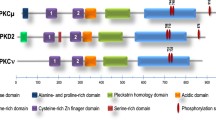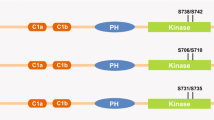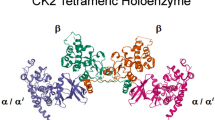Abstract
Protein kinase C (PKC) was first described by Nishizuka’s laboratory in 1977 as a proteolytically activated kinase [1–3]. Subsequent work has established the importance of PKC activity in a multitude of cell functions that regulate growth and differentiation in a variety of cell types [4,5]. More recently, molecular cloning approaches have established that PKC is actually a family of closely related isoenzymes [6,7]. These include the calcium-dependent isoenzymes a, βI, βII, and γ; the calcium-independent isoenzymes δ, ε, η, θ, and µ; and the atypical isoenzymes, ζ and i(λ) (Table 1). These enzymes are the products of distinct genes, with the exception of PKC βI and βII, which are derived from alternative splicing of a single gene. The PKC enzymes are structurally quite similar. They are composed of a single polypeptide chain with a regulatory domain at the amino terminus and a catalytic domain at the carboxyl terminus. The isoenzymes can be divided into four regions that are conserved across isoenzymes (C1-C4) and five regions that vary between isoenzymes but are conserved within the isoenzyme across species (V1-V5) [9,10].
Access this chapter
Tax calculation will be finalised at checkout
Purchases are for personal use only
Preview
Unable to display preview. Download preview PDF.
Similar content being viewed by others
References
Takai Y, Kishimoto A, Inove M, Nishizuka Y (1977) Studies on a cyclic nucleotide-indepen-dent protein kinase and its proenzyme in mammalian tissues and purification and characterization of an active enzyme from bovine cerebellum. J Biol Chem 252:7603–7609.
Takai Y, Kishimoto A, Iwasa Y, et al. (1979) Calcium-dependent activation of a multifunctional protein kinase by membrane phospholipids. J Biol Chem 254:3692–3695.
Kishimoto A, Takai Y, Mori T, Kikkawa V, Nishizuka Y (1980) Activation of calcium and phospholipid-dependent protein kinase by diacylglycerol, its possible relation to phosphatidylinositol turnover. J Biol Chem 255:2273–2276.
Nishizuka Y (1986) Studies and perspectives of protein kinase C. Science 233:305–312.
Nishizuka Y (1989) Studies and perspectives of the protein kinase C family for cellular regulation. Cancer 63:1892–1903.
Nishizuka Y (1988) The molecular heterogeneity of protein kinase C and its implications for cellular regulation. Nature 334:661–665.
Hug H, Sarre TF (1993) Protein kinase C isoenzymes: Divergence in signal transduction? Biochem J 291:329–343.
Dekker K, Parker P (1994) Protein kinase C — a question of specificity. Trends Biochem Sci 19:73–77.
Parker PJ, Coussens L, Totty N, et al. (1986) The complete primary structure of protein kinase C — the major phorbol ester receptor. Science 233:853–859.
Coussens L, Parker PJ, Rhee L, et al. (1986) Multiple, distinct forms of bovine and human protein kinase C suggest diversity in cellular signaling pathways. Science 233:859–866.
Blobe GC, Obeid LM, Hannun YA (1994) Regulation of protein kinase C and role in cancer biology. Cancer Metastasis Rev 14:411–421.
O’Brian CA, Vogel VG, Singletary SE, Ward NE (1989) Elevated protein kinase C expression in human breast tumor biopsies relative to normal breast tissue. Cancer Res 49:3215–3217.
Wyss R, Fabbro D, Regazzi R, Borner C, et al. (1987) Phorbol ester and epidermal growth factor receptors in human breast cancer. Anticancer Res 7:721–728.
Imber R, Haberthür F, Meier F, Filipuzzi I, Almendral AC (1994) No tumor-specific expression levels of protein kinase C isoenzymes and of c-fos in human breast cancer cell cultures. Carcinogenesis (Lond) 15:359–363.
Fabbro D, Kiing W, Roos W, Regazzi R, Eppenberger U (1986) Epidermal growth factor binding and protein kinase C activities in human breast cancer cell lines: Possible quantitative relationship. Cancer Res 46:2720–2725.
Borner C, Wyss R, Regazzi R, Eppenberger U, Fabbro D (1987) Immunological quantitation of phospholipid/Ca2+-dependent protein kinase of human mammary carcinoma cells: Inverse relationship to estrogen receptors. Int J Cancer 40:344–348.
Neidel JE, Kohn LJ, Vandenbark GR (1983) Phorbol diester receptor copurifies with protein kinase C. Proc Natl Acad Sci USA 80:36–40.
Castagna M, Takai Y, Kaibuchi K, et al. (1982) Direct activation of calcium-activated, phos-pholipid-dependent protein kinase by tumor-promoting phorbol esters. J Biol Chem 257:7874–7851.
Osborne CK, Hamilton B, Nover M, Ziegler J (1981) Antagonism between epidermal growth factor and phorbol ester tumor promoters in human breast cancer cells. J Clin Invest 67:943–951.
Roos W, Fabbro D, Kiing W, Costa SD, Eppenberger U (1986) Correlation between hormone dependency and the regulation of epidermal growth factor receptor by tumor promoters in human mammary carcinoma cells. Proc Natl Acad Sci USA 83:991–995.
Darbon J-M, Valette A, Bayard F (1986) Phorbol esters inhibit the proliferation of MCF-7 cells. Biochem Pharmacol 35:2683–2686.
Valette A, Gas N, Jozan S, et al. (1987) Influence of 12–0-tetradecanoylphorbol-13-acetate on proliferation and maturation of human breast carcinoma cells (MCF-7): Relationship to cell cycle events. Cancer Res 47:1615–1620.
Issandou M, Bayard F, Darbon J-M (1988) Inhibition of MCF-7 cell growth by 12–0-tetradecanoylphorbol-13-acetate and 1,2-dioctanoyl-sn-glycerol: Distinct effects on protein kinase C activity. Cancer Res 48:6943–6950.
Kennedy MJ, Prestigiacomo L, Tyler G, May WS, Davidson N (1992) Differential effects of bryostatin-1 and phorbol ester on human breast cancer cells. Cancer Res 52:1278–1283.
Nutt JE, Harris AL, Lunec J (1991) Phorbol ester and bryostatin effects on growth and the expression of oestrogen responsive and TGF-β1 genes in breast tumour cells. Br J Cancer 4:671–676.
Fabbro D, Regazzi R, Costa SD, Borner C, Eppenberger U (1986) Protein kinase C desensi-tization by phorbol esters and its impact on growth of human breast cancer cells. Biochem Biophys Res Commun 135:65–73.
Darbon J-M, Oury F, Clamens S, Bayard F (1987) TPA induces subcellular translocation and subsequent down-regulation of both phorbol ester binding and protein kinase C activities in MCF-7 cells. Biochem Biophy Res Commun 146:537–546.
Ree AH, Landmark BF, Walaas SI, et al. (1991) Down-regulation of messenger ribonucleic acid and protein levels for estrogen receptors by phorbol ester and calcium in MCF-7 cells. Endocrinology 129:339–344.
Saceda M, Knabbe C, Dickson RB, et al. (1991) Post-transcriptional destabilization of estrogen receptor mRNA in MCF-7 cells by 12–0-tetradecanoylphorbol-12-acetate. J Biol Chem 25:17809–17812.
Lee CSL, Koga M, Sutherland RL (1989) Modulation of estrogen receptor and epidermal growth factor receptor mRNAs by phorbol ester in MCF-7 breast cancer cells. Biochem Biophys Res Commun 162:415–421.
Ormandy CJ, Lee CSL, Kelly PA, Sutherland RL (1993) Regulation of prolactin receptor expression by the tumor promoting phorbol ester 12–0-tetradeccanoylphorbol-13-acetate in human breast cancer cells. J Cell Biochem 52:47–56.
Guerin M, Prats H, Mazars P, Valette A (1992) Antiproliferation effect of phorbol esters on MCF-7 human breast adenocarcinoma cells: Relationship with enhanced expression of transforming growth factor-β1. Biochim Biophys Acta 1137:116–120.
Schwartz GK, Redwood SM, Ohunma T, et al. (1990) Inhibition of invasion of invasive human bladder carcinoma cells by protein kinase C inhibitor staurosporine. J Natl Cancer Inst 82:1753–1756.
Dumont JA, Jones WD, Bitonti AJ (1992) Inhibition of experimental metastasis and cell adhesion of B16F1 melanoma cells by inhibitors of protein kinase C. Cancer Res 52:1195–1200.
Johnson MD, Torri JT, Lippman ME, Dickson RB (1994) Regulation of the invasiveness of the human breast cancer cell line MCF-7 by agents that act through protein kinase C (abstr). J Cell Biochem 18D(Suppl):243.
Fine RL, Patel J, Chabner BA (1988) Phorbol esters induce multidrug resistance in human breast cancer cells. Proc Natl Acad Sci USA 85:582–586.
Lee SA, Karaszkiewicz JW, Anderson WB (1992). Elevated level of nuclear protein kinase C in multidrug-resistant MCF-7 human breast carcinoma cells. Cancer Res 52:3750–3759.
Blobe GC, Sachs CW, Khan WA, et al. (1993) Selective regulation of expression of protein kinase C (PKC) isoenzymes in multidrug-resistant MCF-7 cells. J Biol Chem 268:658–664.
Yu G, Ahmad A, Aquino C, et al. (1991) Transfection with protein kinase C α confers increased multidrug resistance to MCF-7 cells expressing P-glycoprotein. Cancer Commun 3:181–189.
Ahmad S, Trepei JB, Ohno S, et al. (1992) Role of protein kinase C in the modulation of multidrug resistance: Expression of the atypical 03B3 isoform of protein kinase C does not confer increased resistance to doxorubicin. Mol Pharmacol 42:1004–1009.
Ways DK, Kukoly CA, deVente J, et al. (1995) MCF-7 breast cancer cells transfected with protein kinase C-03B1 exhibit altered expression of other protein kinase C isoforms and display a more aggressive neoplastic phenotype. I Clin Invest 95:1–10.
O’Brian CA, Liskamp RM, Solomon DH, Weinstein IB (1985) Inhibition of protein kinase C by tamoxifen. Cancer Res 45:2462–2465.
O’Brian CA, Liskamp RM, Solomon DH, Weinstein IB (1986) Triphenylethylenes: A new class of protein kinase C inhibitors. J Natl Cancer Inst 76:1243–1247.
O’Brian CA, Housey GM, Weinstein IB (1988) Specific and direct binding of protein kinase C to an immobilized tamoxifen analogue. Cancer Res 48:3626–3629.
Bignon E, Ogita K, Kishimoto A, Nishizuka Y (1990) Protein kinase C subspecies in estrogen receptor-positive and -negative human breast cancer cell lines. Biochem Biophys Res Commun 171:1071–1078.
Trump DL, Smith DC, Ellis PG, et al. (1992) High-dose oral tamoxifen, a potential multidrug-resistance-reversal agent: Phase I trial in combination with vinblastine. J Natl Cancer Inst 84:1811–1816.
Seynaeve CM, Stetler-Stevenson M, Sebers S, et al. (1993) Cell cycle arrest and growth inhibition by the protein kinase antagonist UCN-01 in human breast carcinoma cells. Cancer Res 53:2081–2086.
Berkow RL, Kraft AS (1985) Bryostatin, a non-phorbol macrocyclic lactone, activates intact human polymorphonucler leukocytes and binds to the phorbol ester receptor. Biochem Biophys Res Commun 131:1109–1115.
Gschwendt M, Fürstenberger G, Rose-John S, et al. (1988) Bryostatin 1, an activator of protein kinase C, mimics as well as inhibits biological effects of the phorbol ester TPA in vivo and in vitro. Carcinogenesis (Lond) 9:555–562.
Kraft AS, Baker VV, May WS (1987) Bryostatin induces changes in protein kinase C location and activity without altering c-myc gene expression in human promyelocytic leukemia cells (HL-60). Oncogene 1:111–118.
May WS, Sharkis SJ, Esa A, et al. (1987) Antineoplastic bryostatins are multipotential stimulators of human hematopoietic progenitor cells. Proc Natl Acad Sci USA 84:8483–8487.
Pettit GR, Dey JF, Hartwell JL, Wood HB (1970) Antineoplastic components of marine animals. Nature 227:962–963.
Hennings H, Blumberg PM, Pettit GR, et al. (1987) Bryostatin 1, an activator of protein kinase C, inhibits tumor promotion by phorbol esters in SENCAR mouse skin. Carcinogenesis (Lond) 8:1343–1346.
Prendiville J, Crowther D, Thatcher N, et al. (1993) A phase I study of intravenous bryostatin 1 in patients with advanced cancer. Br J Cancer 68:418–425.
Philip PA, Rea D, Thavasu P, et al. (1993) Phase I study of bryostatin 1: Assessment of interleukin 6 and tumor necrosis factor a induction in vivo. J Natl Cancer Inst 85:1812–1818.
Stanwell C, Gescher A, Bradshaw TD, Pettit GR (1994) The role of protein kinase C isoenzymes in the growth inhibition caused by bryostatin 1 in human A549 lung and MCF-7 breast carcinoma cells. Int J Cancer 56:585–592.
Grant S, Jarvis WD, Swerdlow PS, et al. (1992) Potentiation of the activity of 1–β-D-arabinofuranosyl-cytosine by the protein kinase C activator bryostatin 1 in HL-60 cells: Association with enhanced fragmentation of mature DNA. Cancer Res 52:6270–6278.
Editor information
Editors and Affiliations
Rights and permissions
Copyright information
© 1996 Kluwer Academic Publishers
About this chapter
Cite this chapter
Davidson, N.E., Kennedy, M.J. (1996). Protein kinase C and breast cancer. In: Dickson, R.B., Lippman, M.E. (eds) Mammary Tumor Cell Cycle, Differentiation, and Metastasis. Cancer Treatment and Research, vol 83. Springer, Boston, MA. https://doi.org/10.1007/978-1-4613-1259-8_5
Download citation
DOI: https://doi.org/10.1007/978-1-4613-1259-8_5
Publisher Name: Springer, Boston, MA
Print ISBN: 978-1-4612-8536-6
Online ISBN: 978-1-4613-1259-8
eBook Packages: Springer Book Archive




